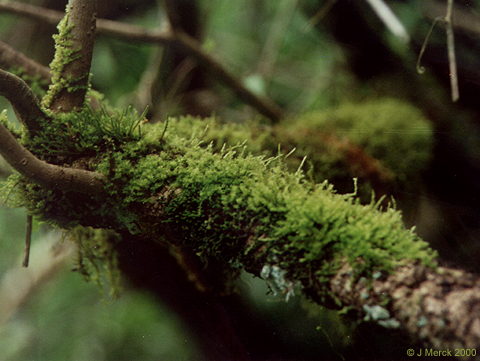
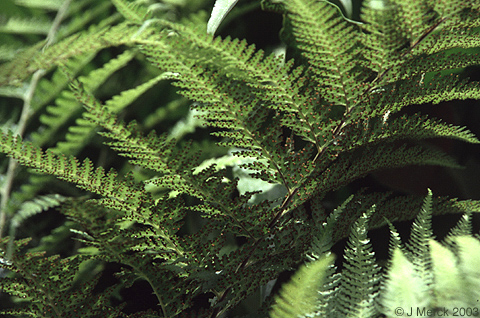 Vascular plants possess
Vascular plants possess
- Vascular tissue of tubes to allow water and nutrients to move where it is needed in the plant.
- Waxy surface to prevent dessication. Air is allowed in and out of tissues by means of specialized openings called stomata.
Primitive vascular plants include:
They retain:- Lack of seeds or flowers.
- Reproduction by means of spores.
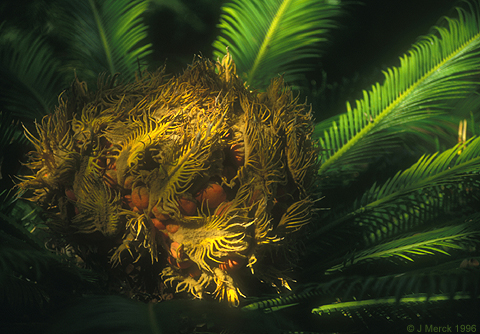 Seed plants: More derived vascular plants, seed plants, are characterized by seeds (duh) in which the embryonic plant is provided with a food source and protected. They can also possess woody tissues that enable them to achieve considerable size on land. They include:
Seed plants: More derived vascular plants, seed plants, are characterized by seeds (duh) in which the embryonic plant is provided with a food source and protected. They can also possess woody tissues that enable them to achieve considerable size on land. They include:
- Cycads
- Conifers
- Ginkgoes
- Anthophyta (AKA Angiospermae) - flowering plants.
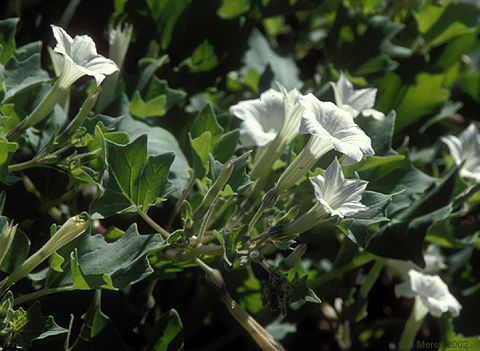 Anthophytes:
Anthophytes:
- Became common during the Cretaceous (roughly 100 million years ago.)
- Seed is sheathed in a protective layer that can develop into fruit.
- Pollination is facilitated by means of a flower that attracts pollinators.
Traditional Linnean taxonomy breaks Angiosperms up into Monocotyledonae (aka "monocots") and Dicotylodonae ("dicots"). It turns out that only some of the dicots (termed "Eudicotyledonae ") form a natural group of closely related organisms. Better to think on the non-Eudicot dicots as "primitive anthophytes." So, we have
- Primitive anthophytes: E.G. magnolias, waterlilies , etc.
- Monocotyledonae: E. G. Bulb plants, orchids, bromiliads, palms, grasses, etc.
- Eudicotyledonae: Most "dicots," including Asteraceae - the daisies. (More on them later.)
In the Galápagos, we will see many eudicots, a few monocots, and, in some environments, a surprising diversity and number of ferns and other primitive vascular plants. We now turn to the subject of the environments in which they occur.
Galápagos Ecology
Ecology: The scientific study of the interactions of organisms with one another and their physical environment. In the Galápagos, we will see manifestations of four major ecological concepts:
- Niche-partitioning: The result of the selective pressure that populations competing for the same resources apply to one another.
- Ecological communities: Recurring, relatively stable associations of species.
- Ecological succession: Recurrent systematic changes in communities through tme
- Environmental energy flow: The movement of solar energy through different portions of the community.
Niche partitioning: Within a given physical environment, species of organisms tend not to be in direct competition with one another. This may be because:
- Native species evolve adaptations that limit competition. Obviously, within a population, those individuals whose behavior brings them into less frequent competition with others have an advantage in passing on their genes. E.G.: Marine and land iguanas, although descended from a recent common ancestor, exploit different food resources, habitats, and nesting sites.
- New immigrants are more likely to become established in an environment if they are adapted to exploit different resources than native organisms or to do so in a radically different way.
- The coevolution of species, E.G. the mutualism of East African acacia trees and the hoofed mammals that feed on their fruit and distribute their seeds)
- An epiphenomenon of the life histories of the individual species.

 The Galápagos have a "classic" set of ecological communities that are readily distinguished by their flora. Ultimately these exist because of a climatic phenomenon: The rain-shadow effect. Prevailing winds blowing across the ocean contain some moisture. When they encounter an island with high elevations, like Isabela or Santa Cruz, they are forced to rise. At higher elevations, they become chilled and their water condenses as rain or mist, which precipitates out at high elevation on the windward side of the island. On the leeward side, there is very little moisture left in the air and the climate is, if anything, more arid than normal. Thus, the larger island have a distinct zonation of moisture that forms the basis for its ecological communities.
The Galápagos have a "classic" set of ecological communities that are readily distinguished by their flora. Ultimately these exist because of a climatic phenomenon: The rain-shadow effect. Prevailing winds blowing across the ocean contain some moisture. When they encounter an island with high elevations, like Isabela or Santa Cruz, they are forced to rise. At higher elevations, they become chilled and their water condenses as rain or mist, which precipitates out at high elevation on the windward side of the island. On the leeward side, there is very little moisture left in the air and the climate is, if anything, more arid than normal. Thus, the larger island have a distinct zonation of moisture that forms the basis for its ecological communities.
The communities, from bottom to top: For each, a typical plant or two are given. Remember these plants and be prepared to learn to identify them in the field.
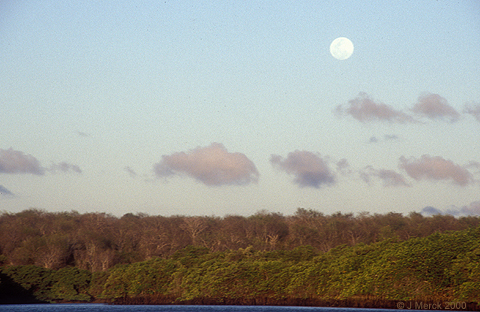
The narrow zone fringing the shore in which groundwater is salt water that has infiltrated from the ocean. This is the home of a special community of plants that can tolerate sea water. Usually, they eliminate salt by means of special glands. Sea water is nasty, but for those who can use it, there is plenty to go around. As a result the boundary between the littoral and arid zones is a marked contrast in greenness, even though both zones get the same rainfall. Some typical plants:
- Saltbush: A common shoreline shrub with fleshy, waxy leaves.
- Thorn shrub: A conspicuous hazard.
Mangroves: A special assembleage of littoral zone plants are the mangroves "mangroves": Salt tolerant shrubs and trees. Mangroves represent a case of convergent evolution and are not one another's closes relatives:
- Black mangroves are more closely related to glorybower
- Red mangroves are more closely related to Old World mangroves
- White and Button mangroves are more closely related to Indian almond
Most have adaptations for the disperasal of their offspring by ocean currents and rooting in shore environments. None are endemic to the Galápagos.
Red mangroves are capable of drastically modifying their environment by sinking their roots directly in to the water. This enables them to trap sediments and form a distinctive underwater environment.
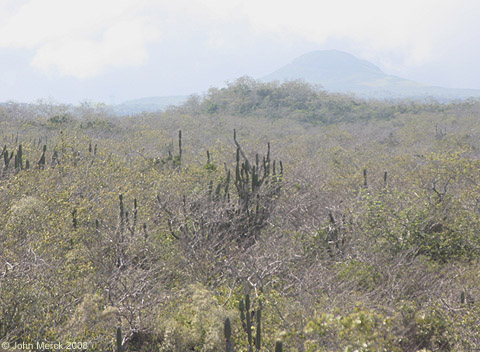
A few meters from the shore, one passes into the typical Galápagos desert. This community is omnipresent at low elevations, once one leaves the zone of salt groundwater. On low-lying islands, the arid zone may go all the way to the highest elevations. Even on tall islands, it extends far up the leeward slopes.
Arid zone plants depend on fresh water but obviously don't need much of it. Plants in this zone show considerable diversity and endemism. A small selection:
- Palo Santo: These trees shed their leaves qucikly after the rainy season. Their bark is covered with a white lichen, giving them the appearance of dead white trees.
- Prickly Pear aka Opuntia: The Galápagos boast a major 14-species endemic adaptive radiation of these common New World cacti. Species tend to reflect adaptations to local herbivores and pollinators. For example, island with giant tortoises and land iguanas tend to have tree-sized prickly-pears like Opuntia megasperma, whereas on herbivore-free islands, the prickly pears are of normal proportions, like Opuntia helleri. This prickly-pear, btw, has reduced thorns to facilitate pollination by Galápagos doves.
- Gray matplant: In places where nothing else grows, you can see these little herbaceous plants.
 Characterized by increasing moisture. Since our highlands tour will take us from the coastal straight to the Scalesia zone, we are unlikely to see the transition zone up close. Some less drought-resistant forms start to appear, including:
Characterized by increasing moisture. Since our highlands tour will take us from the coastal straight to the Scalesia zone, we are unlikely to see the transition zone up close. Some less drought-resistant forms start to appear, including:
- Pega-pega: A deciduous endemic tree with round leaves and sticky fruit.
Galapagos Photos by Dr. Anna E. Ross.)
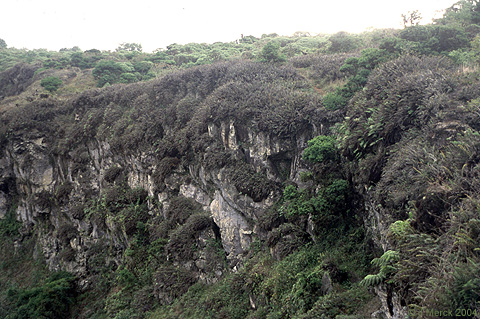
A humid dense forest fed by the garua. It's typical plant is also one of the islands' most interesting:
- Scalesia pedunculata: Besides the prickly-pears, the adaptive radiation of Scalesia, an endemic genus, is the Galápagos' most interesting. Scalesia is a member of Asteraceae - the composite-flowered daisies. In most places, these are little herbaceous plants. Members of Scalesia, however, are all woody shrubs with one exception, Scalesia pedunculata, which is a large tree. These form the backbone of the Galápagos' upland forests. Daisy trees. Wow!
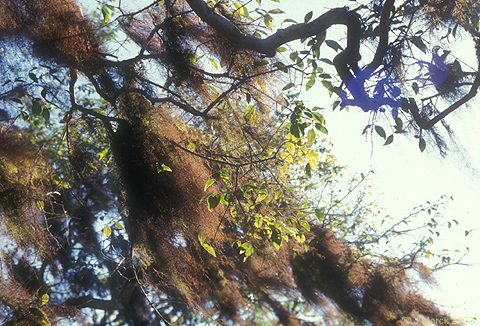
As we ascend, we reach the zone in which the land sometimes sticks up out of the garua and in which the ground doesn't retain moisture as well. Thus, the plant biomass starts to diminish. The zone above the Scalesia zone is an open forest named for the brown lichens and liverworts that cover the trunks of trees, however the common tree is:
- Cat's-claw: A spiny shrub or small tree.
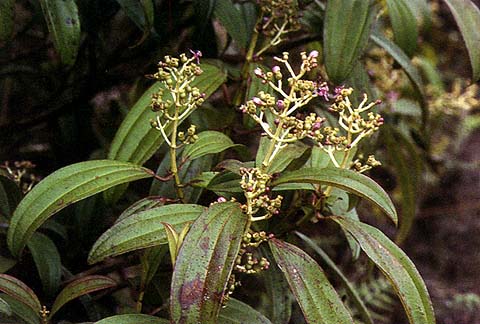
A dense but mostly treeless heath of the shrub Micronia robinsoniana.
(Right: Micronia robinsoniana .)

Above it all is the coolest of all Galápagos zones. The pampa zone is a sedge of ferns (with a few grasses.) In it, one can see a rare example of the kind of environment that was quite common before the evolution of grasses about 50 million years ago. There is no one dominant species, but once can hope to see:
- Galápagos tree fern: As the name implies, a tree-sized fern. Again, this is a reminder of a bygone age. This time, of the coal-swamps of the late Paleozoic, before the proliferation of seed plants.
Pretty neat system. Here's why it doesn't work consistently:
- Based on Santa Cruz and really only ever described that island perfectly. Islands without sufficient elevation to have extensive garua are strictly arid (E.G. Española)
Thus, only Santa Cruz, San Cristóbal, and Isabela, and Santiago show this zonation.
- The moist upland zones happen to be the only places on the Galápagos that were friendly to agriculture, so they have been heavily modified by human activity. Agriculture and introduced species have fragmented and erased natural zonations.
- Introduced mammals (especially goats) have destroyed the Scalesia zone on Santiago and damaged it elsewhere.

Ecological succession
One other reason that communities are not nicely delineated is that they change over time, as well as with elevation, in the process of ecological succession. To take a simple example:
- consider a newly soldidfied glassy lava flow. Not an inviting environment for most plants, that need to sink their roots in soil.
- Nevertheless, some pioneers like the lava cactus and mollugo can root themselves in its cracks.
- As their action weathers the flow and they die, adding their bodies to the mix, a thin soil develops that can sustain slightly fussier plants.
- Over hundreds to thousands of years, this process reiterates until a stable climax forest is present.
This ecological succession doesn't happen automatically. Rather, it represents the equilibrium of opposing forces among the plant communities:
- Rapid flowering at the expense of growth: Pioneers are the plants that sprout and grow fastest and can occcupy ground first. These are usually small herbaceous plants - "wildflowers" or, if you must, "weeds."
- Growing to exclude competitors: Taller woody plants can shade out and eventually eliminate small herbaceous ones.
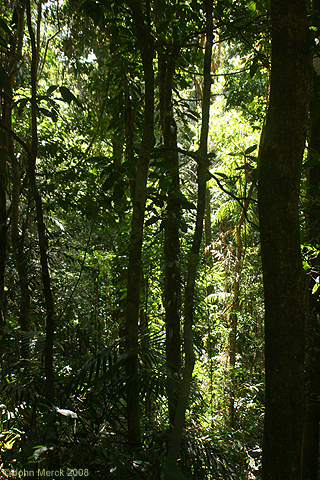 Thus, the first plants to colonize a disturbed area are usually small herbaceous ones that can grow quickly because they have full access to the sulight and aren't wasting metabolic energy on woody tissues. Eventually, however, they are overtopped and shaded out by larger woody shrubs. These, in turn, are eventually shaded out by trees. A climax forest consists mostly of a:
Thus, the first plants to colonize a disturbed area are usually small herbaceous ones that can grow quickly because they have full access to the sulight and aren't wasting metabolic energy on woody tissues. Eventually, however, they are overtopped and shaded out by larger woody shrubs. These, in turn, are eventually shaded out by trees. A climax forest consists mostly of a:
- Canopy of trees
- Understory of shrubby shade-resistant small trees and shrubs.
- Sparse population of forest floor herbaceous plants.
So why do we still have herbaceous pioneer plants? Because there are many limiting factors to forest growth, including:
- Seasons
- Rainfall
- Soil quality
- Limits to tree growth.
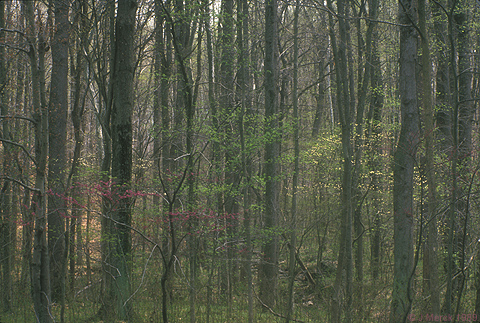 In an our local area we have:
In an our local area we have:
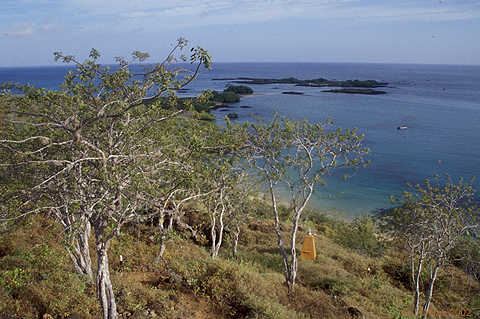 In the Galápagos, the limiting factors are:
In the Galápagos, the limiting factors are:
- Aridity
- Poverty of soils.
 Climate change issues: This brings us to one last headache. While endemism is high in the arid - Scalesia zones, it is very low in the higher-elevation ones. Why? Well, not only do communities change over time, so do climates. Ancient pollen deposits tell us that during the last ice age, the Galápagos were drier than they are now.
Climate change issues: This brings us to one last headache. While endemism is high in the arid - Scalesia zones, it is very low in the higher-elevation ones. Why? Well, not only do communities change over time, so do climates. Ancient pollen deposits tell us that during the last ice age, the Galápagos were drier than they are now.
Thus, the arid zone would have extended much higher up the slopes of the large islands, obliterating the Micronia and pampa zones. Thus, today's high elevation zones are probably no older than the last deglaciation (11,000 years) whereas the lower zones have had millions of years in which endemic forms could evolve.
The last ecological topic, energy flux. we leave for later.

